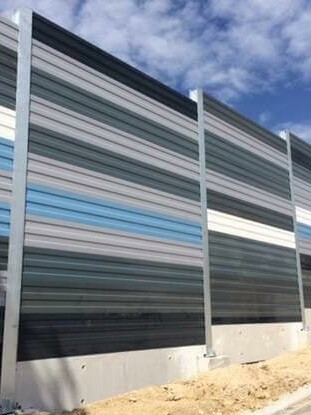
Regulations on road traffic noise reducing devices
- EN 1793-1: Intrinsic characteristics: sound absorption.
- EN 1793-2: Intrinsic characteristics: sound insulation.
- EN 1793-3: Intrinsic characteristics: standard road traffic spectrum for acoustic measurements and testing.
- EN 1794-1: Mechanical performance and stability requirements, e.g. resistance to its own weight, to wind, to projected impacts or others.
- EN 1794-2: General safety and environmental considerations, e.g. fire resistance, falling detached pieces or others.
- EN 14389-1: Long-term performance, acoustical characteristics.
- EN 14389-2: Long-term performance, non-acoustical characteristics.
There are several Eurocodes that we use depending on the nature of the project, the elements forming it, or the environment for which the equipment is intended, for example Eurocode 2 for the design of concrete structures or Eurocode 3 for the design of steel structures.
We use specific instructions, such as IAP-11, IAPF-07, or GCOC. Our team’s experience and the nature of the project determine the most appropriate standard for each situation.
View FAQs
Excessive noise in cities and roads is a threat to human health. High levels of noise cause sleep disturbance, irritability, aggression, respiratory problems, etc. Acoustic screens are the best corrective measure to minimise the spread of noise from road traffic by acting as a barrier between the receiver and the source of the noise. They are therefore the most commonly used anti-noise systems in transport infrastructures, due to their efficiency, rapid installation, and value for money.
The management of noise pollution in transport infrastructure, roads, railways and airports has been mandatory for all authorities since the publication of European and national laws and regulations. Each town or city must have a strategic noise map to regulate the harmful and annoying effects caused to the population. Noise Law 37/2007 and Royal Decrees 1513/2005 and 1367/2007, together with the regional and municipal laws supported by European UNE standards, indicate the obligation to produce an Environmental Impact Statement (EIS) for road and rail projects. Only accredited acoustic engineering companies are authorised to conduct noise and vibration studies in the vicinity of roads, motorways, railway lines, airports, etc. Any company may market this service, provided it subcontracts the study to accredited companies.
We can classify different types of panels based on acoustic values obtained by testing in accredited laboratories. The modular nature of the panels, with minimum, average and maximum sound absorbing and insulating values, means they can be adapted to different solutions, regardless of the height or length of the screen. However, the general performance of the screen must also be based not only on the type of panel (appropriately sized) but also on the quality of the materials used. Consideration must also be given to the weather and the environmental factors to which the panels will be exposed: wind, snow, UV rays, dew, and corrosive or marine environments, etc. All the aspects mentioned as a whole will serve as a guide for project technicians to select the right panel for each project.

